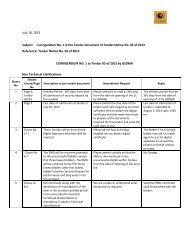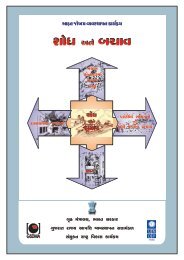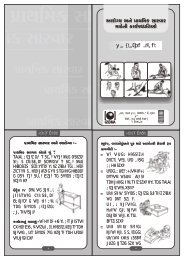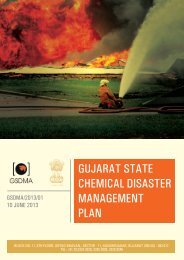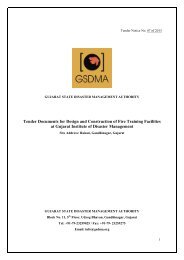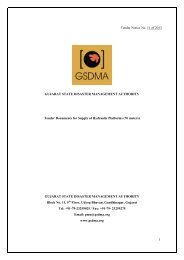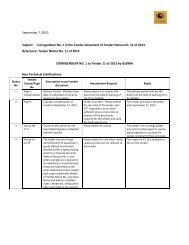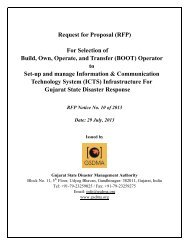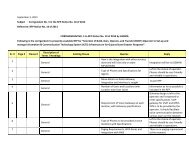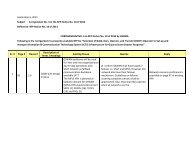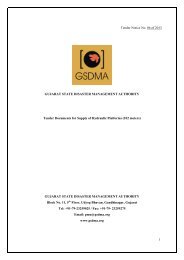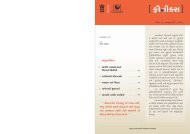Emergency Response Guidebook - Gujarat State Disaster ...
Emergency Response Guidebook - Gujarat State Disaster ...
Emergency Response Guidebook - Gujarat State Disaster ...
You also want an ePaper? Increase the reach of your titles
YUMPU automatically turns print PDFs into web optimized ePapers that Google loves.
GUIDE137Substances - Water-Reactive - CorrosiveERG2012ERG2012Substances - Water-Reactive - CorrosiveGUIDE137POTENTIAL HAZARDSHEALTH• CORROSIVE and/or TOXIC; inhalation, ingestion or contact (skin, eyes) with Vapours, dusts orsubstance may cause severe injury, burns or death.• Fire will produce irritating, corrosive and/or toxic gases.• Reaction with water may generate much heat that will increase the concentration of fumes in the air.• Contact with molten substance may cause severe burns to skin and eyes.• Runoff from fire control or dilution water may cause pollution.FIRE OR EXPLOSION• EXCEPT FOR ACETIC ANHYDRIDE (UN1715), THAT IS FLAMMABLE, some of these materials may burn,but none ignite readily.• May ignite combustibles (wood, paper, oil, clothing, etc.).• Substance will react with water (some violently), releasing corrosive and/or toxic gases and runoff.• Flammable/toxic gases may accumulate in confined areas (basement, tanks, hopper/tank cars, etc.).• Contact with metals may evolve flammable hydrogen gas.• Containers may explode when heated or if contaminated with water.• Substance may be transported in a molten form.PUBLIC SAFETY• CALL EMERGENCY RESPONSE Telephone Number on Shipping Paper first. If Shipping Paper notavailable or no answer, refer to appropriate telephone number listed on the inside back cover.• As an immediate precautionary measure, isolate spill or leak area in all directions for at least 50meters (150 feet) for liquids and at least 25 meters (75 feet) for solids.• Keep unauthorized personnel away.• Stay upwind.• Keep out of low areas.• Ventilate enclosed areas.PROTECTIVE CLOTHING• Wear positive pressure self-contained breathing apparatus (SCBA).• Wear chemical protective clothing that is specifically recommended by the manufacturer. It mayprovide little or no thermal protection.• Structural firefighters' protective clothing provides limited protection in fire situations ONLY; it is noteffective in spill situations where direct contact with the substance is possible.EVACUATIONSpill• See Table 1 - Initial Isolation and Protective Action Distances for highlighted materials. Fornonhighlighted materials, increase, in the downwind direction, as necessary, the isolation distanceshown under “PUBLIC SAFETY”.Fire• If tank, rail car or tank truck is involved in a fire, ISOLATE for 800 meters (1/2 mile) in all directions;also, consider initial evacuation for 800 meters (1/2 mile) in all directions.EMERGENCY RESPONSEFIRE• When material is not involved in fire, do not use water on material itself.Small Fire• Dry chemical or CO 2.• Move containers from fire area if you can do it without risk.Large Fire• Flood fire area with large quantities of water, while knocking down Vapours with water fog. Ifinsufficient water supply: knock down Vapours only.Fire involving Tanks or Car/Trailer Loads• Cool containers with flooding quantities of water until well after fire is out.• Do not get water inside containers.• Withdraw immediately in case of rising sound from venting safety devices or discoloration of tank.• ALWAYS stay away from tanks engulfed in fire.SPILL OR LEAK• Fully encapsulating, Vapour protective clothing should be worn for spills and leaks with no fire.• Do not touch damaged containers or spilled material unless wearing appropriate protective clothing.• Stop leak if you can do it without risk.• Use water spray to reduce Vapours; do not put water directly on leak, spill area or inside container.• Keep combustibles (wood, paper, oil, etc.) away from spilled material.Small Spill• Cover with DRY earth, DRY sand or other non-combustible material followed with plastic sheet tominimize spreading or contact with rain.• Use clean non-sparking tools to collect material and place it into loosely covered plastic containers forlater disposal.• Prevent entry into waterways, sewers, basements or confined areas.FIRST AID• Move victim to fresh air.• Call 108 or emergency medical service.• Give artificial respiration if victim is not breathing.• Do not use mouth-to-mouth method if victim ingested or inhaled the substance; give artificialrespiration with the aid of a pocket mask equipped with a one-way valve or other proper respiratorymedical device.• Administer oxygen if breathing is difficult.• Remove and isolate contaminated clothing and shoes.• In case of contact with substance, immediately flush skin or eyes with running water for at least 20minutes.• For minor skin contact, avoid spreading material on unaffected skin.• Removal of solidified molten material from skin requires medical assistance.• Keep victim warm and quiet.• Effects of exposure (inhalation, ingestion or skin contact) to substance may be delayed.• Ensure that medical personnel are aware of the material(s) involved and take precautions to protectthemselves.Page 214Page 215



